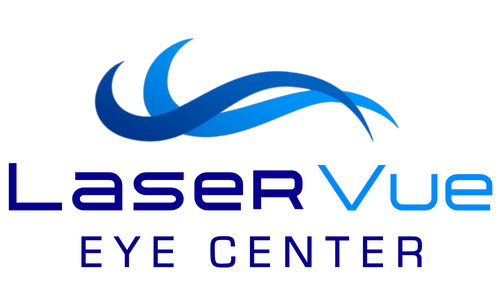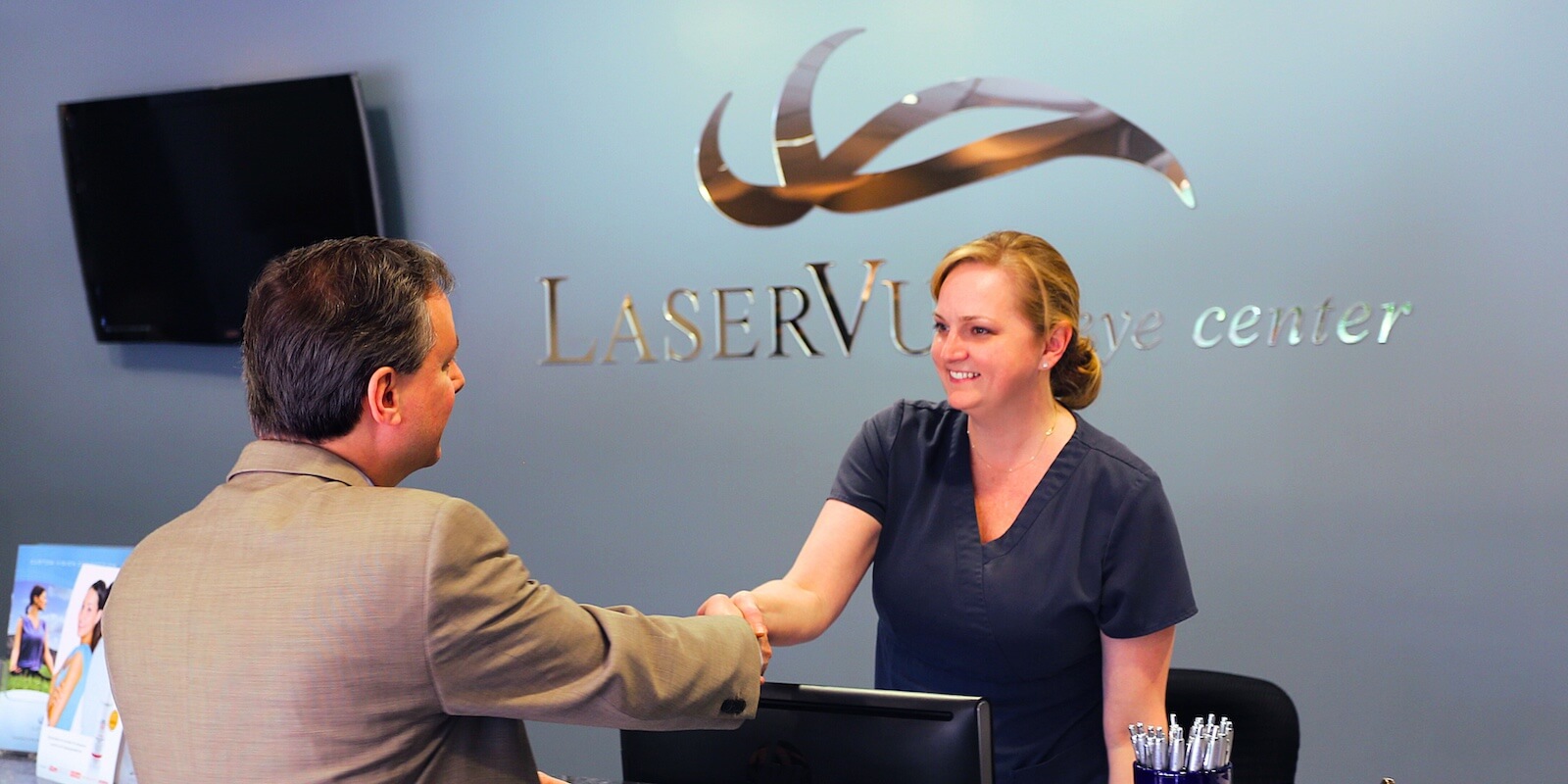Posted by: LaserVue LASIK & Cataract Center in Age-Related Eye Conditions

Aging is an unstoppable natural process that increases the risk of various health conditions. For this reason, adults aged 40 and above are at greater risk of age-related eye conditions like glaucoma and cataracts. This article examines six of the most common age-related eye conditions, noting their prevalence, risk factors, symptoms, and treatment.
Most Common Age-Related Eye Conditions for Age 40 and Older
1. Presbyopia (Age-Related Farsightedness)
Presbyopia is an age-related eye condition caused when the eye lens loses its flexibility and stops focusing light correctly on the retina. As a result, nearby objects become blurry.
The National Eye Institute estimates that the condition is prevalent after 45 years and worsens after 65. Its risk factors include the environment, refractive status, and sex. Women above 40 have a higher prevalence of presbyopia than men in the same age group.
In 2015, approximately 25% of the global population (1.8 billion people) had presbyopia, and 45% of this population needed eye correction treatment. Doctors diagnose presbyopia through a dilated eye exam.
Common Symptoms of Presbyopia in People over 40
- Tired or sore eyes caused by eye strain
- Trouble seeing up close objects
- Headache
- Focusing on reading materials when you hold them farther away from your eyes
Presbyopia Treatment
Presbyopia treatment include surgical interventions and corrective eyewear. Corrective eyewear provides fixed and variable focus lenses, including spectacles and contact lenses.
Please note that no corrective eyewear can fully restore an eye to its initial condition.
Surgical treatment includes modifying the cornea (laser vision correction) or replacement of the natural lens (refractive lens exchange). There is now a daily eyedrop that can help improve near vision as well (ask us about Vuity).
2. Chronic Dry Eye as An Age-Related Eye Condition
Chronic dry eye is a condition caused when the eyes don’t produce enough tears (aqueous deficient dry eye) or your tears evaporate too fast (evaporative dry eye) such that they can’t keep your eyes lubricated. The disease affects nearly 16 million Americans.
Risks for dry eye include being 50 or older, wearing contact lenses, lack of vitamin A, a lot of screen time, and having autoimmune conditions like lupus. Females also have a high prevalence of dry eyes. Untreated, dry eyes can damage the cornea. We use specific testing to diagnose dry eye syndrome.
Common Symptoms of Dry Eye for Those 40 and Older
- Redness
- Blurry vision
- A stinging, burning, or scratchy feeling in the eye
Dry Eye Treatment
Dry eye treatments for aqueous deficient dry eye include over-the-counter eye drops, prescription medicines, lifestyle changes, and punctal plugs. The more common cause of dry eye is evaporative, caused by meibomian gland dysfunction. The LipiFlow Dry Eye Treatment is a drug-free and practical approach to unclog the oil glands, leading to decreased evaporation of the tear film.
The procedure applies heat and massage to the outer and inner eyelids to unblock the meibomian glands and promote the secretion of sufficient oil that prevents the eye’s surface from drying out. LipiFlow takes as little as 12 minutes.
3. Age-Related Development of Cataracts
Cataracts are the leading cause of preventable blindness worldwide. Cataracts are an age-related condition characterized by the clouding or opacification of the lens. It affects 1 in 6 Americans over the age of 50. In 2020, about 78.8 million people aged 50 and above were blind from cataracts. Cataract surgery is the most commonly performed procedure in the US and is very routine and typically an easy recovery to restore clear vision.
Cataracts risk factors include long exposure to radiation or ultraviolet light, genetics, smoking, age, eye injuries, diabetes, and medication. The condition’s diagnosis is through a dilated eye exam.
Common Symptoms of Cataracts in Individuals 40 Years Old or Older
- Bright light sensitivity
- Colors appearing faded
- Blurred or double vision
- Reading difficulty
- Cloudy vision
- Seeing glare and halos around lights
- Previous refractive surgeries stop working or frequent changes in your eyeglass prescription.
Cataracts Treatment
Over 2 million Americans get cataract surgery annually. LaserVue uses a computer-guided laser system to make precise incisions and break cataracts during laser cataract surgery. During cataract surgery, we remove the natural opacified lens and implant an intraocular lens (IOL) that will restore clear vision. The two types of IOLs are standard, and premium. There are a variety of premium lenses that can provide patients with an opportunity to get out of glasses both at distance and for reading.
The surgery is a quick outpatient procedure in 10-15 minutes. Like other surgeries, cataract surgery uses topical anesthesia and relaxing medication given by mouth or IV. Cataract surgery is very safe and has an extremely high success rate.
4. Glaucoma
Glaucoma consists of a group of progressive optic neuropathies that induce intraocular-related damage to the optic nerve. In 2020, 76 million aged 40 to 80 had glaucoma globally.
The most common forms of glaucoma are primary open-angle glaucoma (POAG), which affects about 4 million Americans, and acute angle-closure glaucoma (ACG). POAG develops slowly and is only noticeable after significant vision loss. It clogs the eye’s drainage canal, increasing internal eye pressure and damaging the optic nerve. In ACG, the angle where the iris meets the cornea closes in many areas, causing increased eye pressure and damage to the optic nerve.
Risks of glaucoma include genetics, age, and ethnicity. Hispanics and Latinos over 60 and African Americans over 40 are at higher risk of glaucoma. The condition’s diagnosis is through a dilated eye exam, visual field testing, and optical coherence tomography.
Common Symptoms of Glaucoma After Age 40
- There are no palpable symptoms of glaucoma
- Slow vision loss starts peripherally
Glaucoma Treatment
Glaucoma treatment slows and prevents further damage to the optic nerve by lowering the pressure in the eyes. It is important to catch early signs of glaucoma to prevent further progression of the disease. Treatments involve lowering the pressure inside the eye in the form of eye drops, or surgical techniques.
5. Age-Related Macular Degeneration (AMD)
Age-related macular degeneration (AMD) is a prevalent age-related eye condition and the leading cause of blindness in adults over 55. It occurs due to the buildup of drusen (a waste-like material) in the macula, the part of the retina responsible for central vision. The early type of AMD is called dry, in which there is a build up of drusen causing permanent damage to the photoreceptors. Wet AMD is less common than dry AMD, and occurs when new blood vessels begin to form that can bleed and leak causing blurry vision or vision loss.
AMD has a global prevalence of 170 million and 11 million in the United States. Its risks include being 55 or above, having a family history of AMD, being Caucasian, and smoking. AMD diagnosis is through a dilated eye exam.
Common Symptoms of AMD in People over 40
- Straight lines appearing crooked
- A blurry area near the center of your vision, which gets more prominent over time
- Colors may seem less bright
- Trouble seeing in low lighting
Treatment for AMD
There is no cure for AMD, but early diagnosis is essential to provide the appropriate supplementation to prevent progression of the disease. Injections or laser treatment may be used to control wet AMD and prevent blood vessel formation.
6. Diabetic Retinopathy
Diabetic retinopathy is a diabetes complication caused by high or uncontrolled blood sugar levels, damaging the retina. The condition can cause blindness if not treated. Diabetic retinopathy causes the blood vessels to leak blood into the retina, causing vision loss.
Having diabetes increases the risk of diabetic retinopathy. Diabetes also increases the risk of cataracts by 2 to 5 times. In 2019, 463 million people had diabetes. In 2020, 102.12 million adults had diabetic retinopathy. The condition has no early symptoms, and its diagnosis is through a dilated eye exam.
Common Symptoms of Diabetic Retinopathy for Individuals Over 40
- Blind spots in vision
- Decreased vision or changes in vision
Diabetic Retinopathy Treatment
Laser treatment, eye surgery, and injections are available treatments for severe stages of the condition.
Schedule a Comprehensive Eye Exam at LaserVue Eye Center Today
Annual eye check-ups are very important to catch eye diseases, especially age-related eye conditions, to prevent further progression. At LaserVue Eye Center, our optometrists provide complete eye exams to determine which refractive surgery option is right for you, and we also diagnose and manage eye diseases. Call LaserVue Eye Center now to schedule your consultation or annual eye exam!

